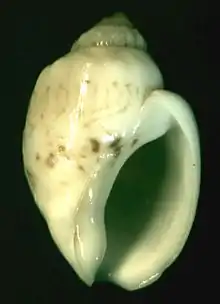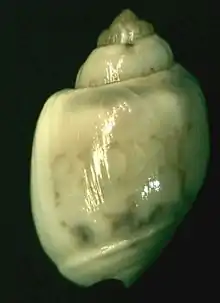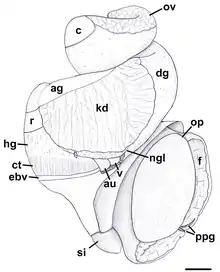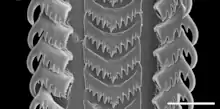Nassodonta dorri
Nassodonta dorri is a species of brackish water snail, with gills and an operculum, a gastropod mollusk in the family Nassariidae, the nassa mud snails or dog whelks.
| Nassodonta dorri | |
|---|---|
 | |
| Nassodonta dorri shell | |
| Scientific classification | |
| Kingdom: | |
| Phylum: | |
| Class: | |
| (unranked): | |
| Superfamily: | |
| Family: | |
| Subfamily: | Anentominae |
| Genus: | |
| Species: | N. dorri |
| Binomial name | |
| Nassodonta dorri (Wattebled, 1886)[1] | |
| Synonyms[2] | |
|
Canidia dorri Wattebled, 1886 | |
Taxonomy
This species was described under the name Canidia dorri by Gustave-Éduard Joseph Wattebled in 1886.[1] Two syntypes are stored in National Museum of Natural History in Paris.[3] The specific name dorri is in honour of captain Émile Dorr (1857-1907) who collected type specimens in North Central Coast region of nowadays Vietnam.[1]
This species was not reported since 1886 until 2001.[3] Kantor & Kilburn (2001)[3] reported on the rediscovery of Nassodonta dorri, described the shell, radula and provided some preliminary anatomical observations based on a single, poorly preserved female, and discussed the family placement of the genus.[4] They also moved this species to the genus Nassodonta within Nassariidae.[3] There was Nassodonta insignis as the only species within the genus Nassodonta.[3]
Simone (2007)[5] provided a description of the external anatomy, proboscis musculature and radula, based on semi-mummified specimens.[4]
Strong et al. provided anatomical and molecular phylogeny analysis and placed it into the newly established subfamily Anentominae and they confirmed the placement of this species within family Nassariidae.[4]
Distribution
Distribution of Nassodonta dorri include Vietnam: lagune de Kao-hai near Huế, Thừa Thiên-Huế Province, Central Vietnam[3] and Phan Ri River, Bình Thuận Province, Southeast Vietnam.[4] It was also reported as abundant species from Nha Trang, Khánh Hòa Province in South Central Coast and from Phan Rang–Tháp Chàm, Ninh Thuận Province.[3]
The type locality is lagune de Kao-hai near Huế.[1]
Description
The shell is thick.[3] The shape of the shell is oblong-ovate.[3] The shell has 2.25 distinctly shouldered whorls.[4][3] The spire is low and obtuse.[3] The body whorl is subcyrindrical.[3] The width of the shell is 8.0-9.6 mm.[3] Shell length is 12.0-14.9 mm.[3]
 Apertural view of a shell of Nassodonta dorri. |
 Abapertural view of a shell of Nassodonta dorri. |
Operculum is thin, elongate, oval with basal nucleus.[4] The length of the operculum is 5.7 mm.[3]
Head is small and broad, with very short, thick cephalic tentacles.[4] Eyes are slightly elevated on prominent ocular peduncles at tentacle outer bases.[4] Foot is broad, fleshy, overlapping sides of operculum in preserved specimens.[4] Frontal part of the foot (propodium) is narrow with posterior extent marked by indistinct notch, poorly demarcated from mesopodium.[4] There is shallow propodial pedal gland along anterior edge, with two histologically distinct subepithelial gland cells.[4] Metapodium has no posterior tentacles.[4]
 Apertural view of anatomy of Nassodonta dorri. ag, albumen gland; au, auricle; c, caecum; ct, ctenidium; dg, digestive gland; ebv, efferent branchial vein; f, foot; hg, hypobranchial gland; kd, kidney; ngl, nephridial gland; op, operculum; ov, ovary; ppg, propodial pedal gland; r, rectum; si, siphon; v, ventricle. |
 Abapertural view of anatomy of Nassodonta dorri. ov, ovary; c, caecum; dg, digestive gland; cm, columellar muscle; ag, albumen gland; cg, capsule gland; r, rectum; ct, ctenidium; os, osphradium; f, foot; p, propodium; t, cephalic tentacle; si, siphon. |
Mantle cavity is short, less than one-half whorl in length.[4] There is reno-pericardial complex just behind the mantle cavity.[4] Mantle cavity is slightly asymmetrical, slightly deeper at left side in front of pericardium.[4]
Reproductive system: has separate sexes (i.e. these snails are dioecious).[4]
Females: ovipositor is forming deep, simple pore surrounded by weakly developed subepithelial glands.[4]
Ecology
Nassodonta dorri live in lower parts of rivers.[3] Reported depth is about 3 m.[3] Nassodonta species live in turbid brackish waters and are capable of withstanding a wide range of salinities.[4]
References
This article incorporates CC-BY-4.0 text from the reference[4]
- Wattebled G. (1886). "Description de mollusques inédits de l'Annam. Récoltes du capitaine Dorr aux environs de Hué". Journal de Conchyliologie 34: 54-71, page 58, plate 3, fig. 5
- Bouchet, P. (2013). Nassodonta dorri. In: MolluscaBase (2017). Accessed through: World Register of Marine Species at http://www.marinespecies.org/aphia.php?p=taxdetails&id=724650 on 2017-11-10
- Kantor, Y. I., & Kilburn, R. N. (2001). "Rediscovery of Canidia dorri Wattebled, 1886, with discussion of its systematic position (Gastropoda: Neogastropoda: Nassariidae: Nassodonta)". Nautilus 115(3): 99-104.
- Strong, E. E., Galindo, L. A., & Kantor, Y. I. (2017). "Quid est Clea helena? Evidence for a previously unrecognized radiation of assassin snails (Gastropoda: Buccinoidea: Nassariidae)". PeerJ 5: e3638. doi:10.7717/peerj.3638.
- Simone L. R. L. (2007). "Family Pseudolividae (Caenogastropoda, Muricoidea): a polyphyletic taxon". American Malacological Bulletin 23(1): 43-78.
External links
| Wikimedia Commons has media related to Nassodonta dorri. |
